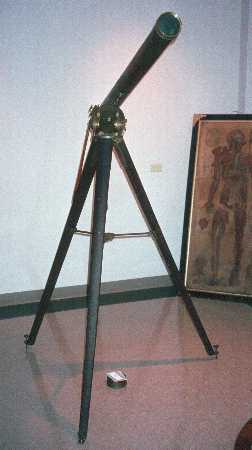| The telescope at the right is the earliest piece of apparatus at Kenyon College in Gambier, Ohio. On its tube is engraved, “This Telescope is Presented to the Right Revd. Philander Chase, Bishop of Ohio, as a small token of respect and Veneration by the Daughter & other Descendants of the Late Reverend William Jones of Nayland County of Suffolk England, for the use of the Students of Kenyon College in the Diocese of Ohio, April 1827”. This is a terrestrial telescope of fairly low power (about 25X) that produces an upright image. Clearly this was a telescope which was originally bought for family, and not scientific, use. The maker is the London firm of Dollond, founded in 1761 by Peter Dollond, who marketed the first achromatic telescopes. This design uses two lens elements of different types of glass to reduce the colored fringes produced by earlier, single-element, lenses. |
| Transylvania University in Lexington, Kentucky was founded
in 1780, and has a remarkable collection of early- to mid-nineteenth century
physics apparatus, now displayed in a museum room.
The telescope by W. and S. Jones of 30 Holborn, London at the right was one of the most expensive items ($720) in the collection. It arrived at Transylvania about 1865, but was made much earlier in the nineteenth century. It has a four inch achromatic objective with a five foot focal length, thus operating at a relative aperture of f/15. Its equatorial mounting is driven by long rods attached through universal joints. It came with an erecting system so that it could be used for terrestrial viewing. REF: Thomas B. Greenslade, Jr., “Collection Profile: Visits to Apparatus Collections II: Transylvania University”, Rittenhouse, 14, 107-114 (2000) |
 |
| John Brashear (1840-1920) was a self-taught glass-worker
from the Pittsburgh area who became a major factor in telescope design
and production in the early part of the twentieth century. He made the
seventy-two inch mirror for the Canadian Dominion University in Victoria,
British Columbia, the contract for which was awarded in 1913.The Diffraction
Gratings ruled by Rowland at Johns Hopkins used blanks made by Brashear.
The first telescope that Brashear made, in 1872, had a five-inch achromatic objective. He worked as a millwright until six, and then worked in his shop with his wife, Phoebe, on the objective and its mount. This later example of a five-inch portable refractor is
in the observatory of Franklin and Marshall College in Lancaster, Pennsylvania.
|
| The best known maker of refracting telescope
objectives in the second halaf of the nineteenth century was Alvan Clark
1804-1887), who worked with his sons Alvan Graham Clark and George Bassett
Clark.
This instrument, with a nine-inch achromatic objective, was manufactured in 1905 by Alvan Clark and Sons, Inc. of Cambridge, Massachusetts and was acquired in 1939 by the University of Vermont. From 1971 to 1989 the telescope was used by the Vermont Astronomical Society. It is now on display in the Collection of Historical Physics Apparatus at the University of Vermont. |
|
The photograph below shows the eleven-inch Alvan Clark telescope in use at Franklin and Marshall College in Lancaster, Pennsylvania. It was acquired by the college in 1885, and was once in a conventional domed observatory. It is now in an observatory with a slide-off room, and is next to a modern research instrument. The mounting was made by Repsold & Sons of Hamburg, Germany.
The Day and Night Telescope by Ashmore of London (below) is in the Kenyon College Collection. "The night telescope is a short telescope, viz., about two feet long, which represents the objects inverted, much enlightened, but not much magnified. Its field of view is also very extensive. This telescope, in consequence of those properties, is used at night mostly by navigators, for the purpose of discovering objects that are not very distant, but which cannot otherwise be seen for want of sufficient light; such as vessels, coasts, rocks, &. ... This object has a pretty large and simple object lens, which it derives its great light". From: Tiberius Cavallo, The Elements of Natural or Experimental Philosophy, Fourth American Edition (Philadelphia, Towar & Hogan, 1829), pg 467
| This model of a terrestrial telescope dates from the early
years of the 20th century. The objective lens and the first magnifier are
fixed, while the erecting lens at the left can be moved back and forth
by the screw. A diagram showing the formation of the images is painted
on the top of the support board. Models of this and other optical devices
were sold by many makers ca. 1900.
The model is in the Jack Judson Collection of the Magic Lantern Museum in San Antonio, Texas. |
The Gregorian Telescope is discussed on another page.